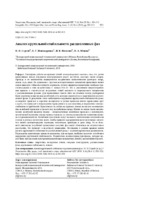| dc.contributor.author | Сергей, И. И. | ru |
| dc.contributor.author | Пономаренко, Е. Г. | ru |
| dc.contributor.author | Потачиц, Я. В. | ru |
| dc.contributor.author | Юдина, Н. А. | ru |
| dc.coverage.spatial | Минск | ru |
| dc.date.accessioned | 2019-11-29T08:02:39Z | |
| dc.date.available | 2019-11-29T08:02:39Z | |
| dc.date.issued | 2019 | |
| dc.identifier.citation | Анализ крутильной стабильности расщепленных фаз = Analysis of the Torsional Stability of Split Phases / И. И. Сергей [и др.] // Энергетика. Известия высших учебных заведений и энергетических объединений СНГ. – 2019. – № 6. – С. 503-513. | ru |
| dc.identifier.uri | https://rep.bntu.by/handle/data/60954 | |
| dc.description.abstract | Специфика работы воздушных линий электропередачи связана с тем, что длина проводников между опорными конструкциями может достигать десятков тысяч метров. Провода и их компоненты подвергаются воздействию климатических факторов: ветра, дождя, льда, снега. По сравнению с другими конструктивными элементами проводники имеют самую высокую гибкость и низкую жесткость, потому являются элементами, наиболее чувствительными к этим воздействиям. С начала 50-х гг. ХХ в. увеличение энергопотребления привело к строительству воздушных линий высокого и сверхвысокого напряжения с расщепленными фазами. Для проводников такого типа на участках между распорками были замечены новые формы колебаний, суть которых заключается в закручивании расщепленной фазы. В результате этого наблюдается нарушение крутильной стабильности фазы: соударение проводов в середине подпролета и трение проволок витого проводника друг о друга, что приводит к повреждению проводников и, как следствие, к нарушению электроснабжения потребителей. Практически на любых воздушных линиях возможно возникновение колебаний проводов в пролете под воздействием ветра. Одним из видов таких механических колебаний является пляска – низкочастотные колебания проводов с амплитудой, достигающей величины стрелы провеса провода, а с учетом возможности удлинения провода и превышающей ее. Колебания при пляске могут вызывать значительные механические усилия и длиться достаточно долго, чтобы привести к разрушению конструктивных элементов линий электропередачи: проводов, изоляторов, арматуры и даже опор. Из-за большой амплитуды колебаний проводники соседних фаз могут сблизиться на недопустимое расстояние, что приведет к короткому замыканию. Поставлена и решена краевая задача расчета крутильной стабильности расщепленной фазы с заданной кратностью расщепления. Определены критические длины подпролетов, при которых наиболее вероятно устойчивое нарушение крутильной стабильности. Разработана компьютерная программа, которая может быть использована при проектировании высоковольтных линий с расщепленной фазой. | ru |
| dc.language.iso | ru | ru |
| dc.publisher | БНТУ | ru |
| dc.title | Анализ крутильной стабильности расщепленных фаз | ru |
| dc.title.alternative | Analysis of the Torsional Stability of Split Phases | ru |
| dc.type | Article | ru |
| dc.identifier.doi | 10.21122/1029-7448-2019-62-6-503-513 | |
| local.description.annotation | The specificity of overhead power lines is associated with the fact that the length of conductors between the supporting structures can reach tens of thousands of meters. Wires and their components are exposed to climatic factors, viz. wind, rain, ice, snow. As compared to other structural elements, conductors are of the highest flexibility and lowest rigidity, and, therefore, they are the most sensitive elements to these effects. Since the early fifties of the XX century, the increase in energy consumption has caused the construction of high and ultra-high voltage overhead lines with split phases. For these types of conductors, new forms of oscillations have been noticed in the areas between the struts, the essence of which is torqueing the split phase. As a result, there is a violation of the torsional stability of the phase: collision of wires in the middle of subspan and friction of wires of stranded conductor against each other, which leads to damaging conductors and, as a consequence, to disruption of power supply to consumers. Almost any overhead lines may be subjected to oscillations of wires in the span under the influence of wind. One of the types of such mechanical oscillations is galloping, i. e. low-frequency oscillations of wires with an amplitude reaching the value of the boom of wire sagging, and, taking into account the possibility of elongation of the wire, even exceeding it. Fluctuations in the galloping can cause significant mechanical forces and last long enough to lead to the destruction of structural elements of power lines, viz. wires, insulators, fittings and even pillars. Due to the large amplitude of oscillations, conductors of neighboring phases can approach each other at an unacceptable distance, resulting in a short circuit. The boundary value problem of the torsional stability calculation of the split phase with a given multiplicity of splitting has been set and solved. The critical lengths of the subspans at which the stable violation of torsional stability is most likely have been determined. A computer program has been developed, which can be used in the design of high-voltage lines with split phase. | ru |

